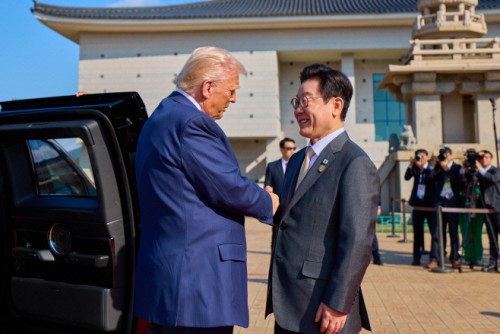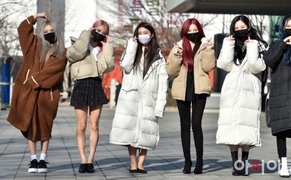 |
| Lee Jae-myung, president of South Korea, greets U.S. President Donald Trump upon his arrival at the Gyeongju National Museum for a bilateral summit on October 29. / Source: Presidential Office |
U.S. President Donald Trump said on October 30 that he has approved South Korea’s construction of nuclear-powered submarines, adding that the vessels would be built at the Philadelphia Shipyard.
Trump wrote on Truth Social that “the U.S.–Korea military alliance is stronger than ever,” and, on that basis, he had approved South Korea “to build nuclear-powered submarines instead of outdated diesel boats.”
He added that South Korea’s nuclear-powered submarines “will be built at the Philadelphia Shipyard,” asserting that U.S. shipbuilding is on the cusp of a major revival.
Hanwha Group acquired the Philadelphia Shipyard in December last year, positioning it as a symbolic hub for U.S.–Korea shipbuilding cooperation. In August, Hanwha announced an additional $5 billion investment as part of the bilateral “MASGA (Make American Shipbuilding Great Again)” initiative. China’s Ministry of Commerce recently placed the yard and four other Hanwha Ocean U.S. subsidiaries on a restricted transactions list, a move seen in Seoul as economic pressure. Trump’s remarks are being interpreted as a signal to push through those headwinds.
The “approval” came a day after a U.S.–Korea summit in which President Lee Jae-myung asked Washington to allow fuel supply for nuclear propulsion. Lee argued that diesel-electric boats have limited submerged endurance and are at a disadvantage tracking North Korean and Chinese submarines, adding that Korean-built boats carrying conventional weapons and patrolling nearby waters would also ease the U.S. Navy’s burden.
National Security Office chief Wi Sung-lac said Trump agreed in principle and that the two sides would pursue follow-up consultations.
This is the first time Seoul has formally stated its intent to acquire nuclear-powered submarines (SSNs) that do not carry nuclear weapons. Developing such boats would require a compact reactor and access to low-enriched uranium fuel—steps that would need U.S. consent.
Under the Biden administration, Washington launched the AUKUS partnership with the UK and Australia to provide Australia with nuclear-powered submarines; South Korea was not included in that arrangement.
Trump also said on trade that “in exchange for U.S. tariff reductions, South Korea agreed to pay $350 billion,” adding that Seoul would purchase large volumes of U.S. oil and gas and that Korean corporations and wealthy investors would invest “more than $600 billion” in the United States.
The Presidential Office said Wednesday that of the $350 billion in planned U.S. investment, $200 billion would be cash invested directly with an annual cap of $20 billion, while the remaining $150 billion would be tied to shipbuilding-cooperation projects.
Most Read
-
1
-
2
-
3
-
4
-
5
-
6
-
7





















